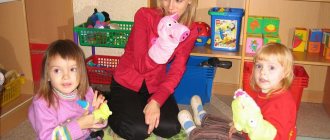Features of the emotional development of a preschool child
The problem of our time is that many children have problems in emotional development, namely, they do not know how to respond to the feelings and states of others, and react inadequately to many things. Today, a child’s best friends are a TV and a computer, a smartphone and a tablet, and his favorite activities are watching cartoons and computer games. As a result of this lifestyle, children communicate less with both adults and peers; Preschoolers are not attentive and insensitive to others, they do not know how to control and show emotions appropriately. But communication significantly enriches life, making it bright, filled with emotions and impressions.
The preschool period is a fairly short period of human life. Therefore, it is important to lay good personality foundations at this time. Equally important is the emotional development of the child, which has its own special characteristics.
When a child is 1-3 years old, his emotional sphere is characterized by:
- lack of empathy
- characteristic emotional reactions associated with his desires
- inability to choose and make decisions
- egocentrism
- the emergence of self-awareness (the baby begins to recognize his reflection in the mirror, respond to his name, tries to be independent, begins to use the pronoun “I”
- high self-esteem (I am good)
- inability to see the consequences of actions
- the importance for the child of an adult’s assessment and reaction.
At the age of 4-6 years, the emotional sphere of the child is characterized by:
- a calmer emotional background of perception
- manifestation of emotions along the chain “desire, idea, action, emotion”
- more controlled emotional processes
- development of emotional anticipation (the child tries to anticipate the future result and how it will be evaluated)
- the appearance of affective reactions
- the emergence of new motives for activity
- the ability to evaluate one's behavior.
A 4-5 year old child is a small person with a fairly diverse range of emotions. His feelings and experiences are connected, to a large extent, with the atmosphere in the family circle. New skills and interests contribute to the emergence of a whole range of different emotions of the child, as well as needs and motives. A preschooler's range of emotions and feelings gradually becomes more complex: he can already feel not only joy or fear, but also jealousy, sadness, pity, anger, cheerfulness, tenderness, shyness, surprise, pleasure, etc. A preschooler can already express feelings using different intonation and facial expressions.
Features of the development of the emotional sphere of preschool children:
- they still cannot control their emotions and experiences
- they master social forms of expressing feelings
- their feelings and emotions become more reasonable and voluntary
- preschoolers begin to develop higher feelings (aesthetic, moral, intellectual).
Watch a video about the importance of emotional and sensory education of a person
If you want to find out to what extent your child has developed certain emotions and feelings, we recommend that you resort to methods for diagnosing the child’s emotional sphere.
Diagnosis of the emotional sphere of preschool children
Both the institution’s psychologists and the parents themselves can study the level of development of the emotional sphere.
- Amen's anxiety test. The child is offered several pictures where the outline depicts children at different moments: in class, in a game, during a conversation with the teacher. The child must imagine the face of the children in the picture: happy or sad, and answer why he thinks so. If the baby notices negative manifestations in most of the pictures, then we can talk about increased emotional anxiety of the subject.
- Luscher color test. The child uses color to show his attitude to the situation being described.
- Drawing tests. Diagnostics takes place in two stages: drawing and discussion. A theme for the drawing is given, for example, “I’m in class,” “The road to kindergarten.” There is no time limit for illustration. The specialist records all the events that happen while the child is working: how often he paused, what he erased from the drawing, the little artist’s comments. After finishing the work, the presenter is interested in what the child drew, who he depicted next to him, what emotions the characters in the picture experience and why.
Diagnostics
Basic diagnostic methods for the emotional sphere of children:
- testing
- observation
- survey
- conversation
- survey
- analysis of samples of children's creativity (drawings).
When observing a preschooler, pay attention to factors such as emotional background, mood, degree of expression of emotions, level of emotional mobility. By observing, you can easily notice how rich the child’s emotional background is, whether the child knows how to control his emotions, and whether he is characterized by emotional instability.
Using one of the diagnostic methods or in combination, you can find out:
- How adequate is the preschooler’s reaction to phenomena?
- how he perceives and interprets the states and moods of other people
- the breadth of the range of emotions that the child understands and experiences, the depth of his experiences, ways of conveying emotions through speech;
- Is it appropriate to display emotions during communication?
These methods can be used by both professional child psychologists and kindergarten teachers.
Correction of the emotional sphere of preschool children
- Games to eliminate emotional stress. During such exercises, the preschooler learns to show his feelings using words and gestures. For example, in a game, the teacher invites participants to hug their friend and pat him on the shoulder or head. Or, dancing in a circle, children try to show a sad bear or a happy squirrel with their movements.
- Psycho-gymnastics. Exercises that alternately cause tension and relaxation will help relax muscles and relieve nervous excitement.
- Music therapy. Classical music puts the baby in a positive mood and neutralizes depression.
- Games to imitate the mood.
- Massage points on the palms, face, crown, under the kneecap.
The full and correct development of the emotional sphere is extremely important for the formation of the personality of a preschooler. After all, it affects the cognitive processes and motivation of the child’s behavior.
By
Empathy in children
The most important component of the emotional development of a preschool child is the development of empathy, namely the ability to sympathize and understand the experiences and emotions of other people. A child who has developed empathy will always put himself in the position of this or that person and offer him his help.
"This is interesting. The author of the theory of emotional intelligence, Daniel Goleman, is convinced that success in life depends not only on the level of intelligence, but also on a good ability to manage one’s own emotions. And by understanding one’s own emotions, a person will feel and be aware of the emotions of others.”
Forming empathy in a preschooler is the key to successful schooling, easy socialization, and problem-free communication. If only for this reason, parents should definitely pay attention to the development of empathy along with the development of the child’s intellectual, communication, cognitive, creative and other abilities.
Tips for developing empathy:
- Create a warm atmosphere in the family where love and mutual understanding will reign.
- Discuss different life situations with your child.
- Introduce your child to the principles of existence in society.
- Explain how to properly deal with people in different situations.
- Explain what consequences this or that behavior of people may have.
- Develop positive social character traits in your child: optimism, trust, forgiveness, solidarity.
- Teach your child to do useful things and help others. Don't forget about praise.
- Empathize with the child, communicate with him about how he feels.
- Develop your child emotionally: discuss thematic images and photographs, depict emotions in front of the mirror, play emotional games.
- Be a role model for your child: adhere to the same principles that you teach your child.
What helps develop the emotional sphere?
Play activities, in particular role-playing games, perfectly help develop the humane feelings of a preschooler. By playing with other children, the baby learns to understand others, sympathize with them, understand their desires, state, and mood. By older preschool age, the child gradually moves from simply recreating, playing out situations or feelings to conveying the emotions that the game contains. The child learns to empathize with others and share their feelings.
Introducing a preschooler to work that is aimed at achieving a result that is useful to others gives the child new emotions: sympathy for the efforts of other children, joy from achieving a common goal, satisfaction from his work or dissatisfaction if he did it poorly.
Playing sports also brings a lot of emotional discoveries to the child. He learns to be patient, strive for goals, experience first failures and enjoy achievements. In group sports, children learn cohesion, responsibility for their actions to others, and learn to work together for sports results.
Any cognitive activity will certainly enrich the emotional baggage of a preschooler. This is the joy of a new discovery (even if not so global), doubts, surprise, the desire to make another discovery for yourself.
Aesthetic feelings develop in preschool children in the process of their own creative activity and communication with art. Beautiful sculptures, paintings, and literary works help the child learn such concepts as “beautiful,” “harmony,” “taste,” “terrible,” “true,” “false,” “truth,” “good,” “evil.” A preschooler learns not only to express his emotions through artistic means, but also to defend the truth, protest against lies and evil, and appreciate the good and beautiful in people.
Emotional impact
The secret of raising a preschooler with the help of emotional influence is not to suppress the child’s emotions, but to direct them in the right direction.
If a child attends kindergarten, then his emotional development will be more effective, since he will be in the company of peers and, together with them, comprehend new things, learn to communicate with them.
Work on the emotional improvement of preschoolers should be carried out in two directions:
- developing the ability to recognize and compare emotions: fun, boring, sad, calm, scary, interesting, etc.
- developing the ability to correctly express emotions and identify the emotions experienced by others.
The emotional impact on the child is carried out by the following means:
- role-playing games
- psycho-gymnastic games
- outdoor games
- communication games
- games and tasks to develop arbitrariness
- games for developing imagination
- game exercises
- mimic sketches
- listening to music and discussing it
- reading fairy tales and stories
- acquaintance with painting.
During classes, the child will experience different emotional states, will try to talk about what he feels, will get acquainted with the experiences of the same children, thanks to which he will begin to better understand himself and those around him.
Work in conditions of emotional development
The formation of positive emotions is most productively facilitated by organized creative activities, such as drawing, modeling, and appliqué.
With the help of activities of this kind, the child has the opportunity not only to express his feelings and experiences, to embody them in an unusual form, but also to see the mood of other children.
Children are very proud of the results of their work
Music lessons, which evoke various associations and contribute to the emergence of new feelings associated with the perception of music, have a good effect on emotional development. The child will feel a spectrum of different sensations: joy from the cheerful sound of a march, sadness from a sad melody. Work is very important for the development of positive emotions, because when a child sees the result of his activities, he immediately experiences emotional uplift and satisfaction from what has been achieved. In the process of activity, he feels his own social significance, experiences a lot of joy from communication, approval of adults and children.
Formation of the emotional sphere
The formation of emotions and feelings in preschoolers depends on the following conditions :
- A preschooler must communicate with peers: it is in communication that feelings and emotions are formed.
- It is necessary to organize purposeful activities that promote the development of emotions and feelings (listening to music, music lessons, reading).
- It is best to develop emotions and feelings in preschoolers through their main activity - play.
- Labor and creative activity helps to form emotional experiences: joy from success, inspiration, sympathy for the efforts of peers, a feeling of satisfaction or dissatisfaction with the result.
“Did you know that if a person is emotionally well, then he has high self-esteem, he is goal-oriented, has no communication problems, and can easily build and maintain relationships. That is, emotional well-being is a guarantee of a child’s success in the future. The emotional well-being of a child depends not on his innate characteristics, but on the optimal system of upbringing in the family.”
Components of successful formation of the emotional sphere of a preschooler:
- Proper organization of the child’s routine, comfortable for him.
- Activation of the baby’s motor activity, his physical development (morning exercises, outdoor games, physical education sessions).
- Games (role-playing, story-based, didactic, communicative, etc.).
- Introduction to art and independent creativity.
- Reading and discussing fairy tales.
- Psycho-gymnastics (emotional sketches, facial expressions, pantomime).
- Organization of joint activities of children.
- Tasks using visual aids.
Emotions are the basis for a child’s successful mental state, his successful communication, development and future life. The baby reacts to the world around him through emotions. Therefore, it is necessary to develop the emotional sphere of a child from an early age using different types of influence, giving preference to play methods.
A person’s relationship to the world around him is not only understood by him and manifested in actions, but also experienced in the form of emotions. Emotions are one of the forms of reflection of the real world by consciousness.Accompanying almost any manifestation of a subject’s activity, emotions serve as one of the main mechanisms of internal regulation of mental activity and behavior aimed at satisfying current needs.
The emotional sphere is an important component in the development of preschoolers, since no communication or interaction will be effective if its participants are not able, firstly, to “read” the emotional state of another, and secondly, to manage their emotions. Understanding your emotions and feelings is also an important point in developing the personality of a growing person.
The formation of a person’s emotions is the most important condition for his development as a person. The extreme variety of human emotions is explained by the complexity of the relationship between the objects of his needs, the specific conditions of their occurrence and the activities aimed at achieving them. The class of emotions includes: moods, feelings, affects, passions, stress. These are the so-called “pure” emotions. They are included in all mental processes and human states.
Preschool childhood is a very short period in a person’s life, only the first seven years. One of the main directions of mental development in preschool age is the formation of the foundations of personality. The child begins to become aware of his “I”, his activity, activity, and begins to objectively evaluate himself. The emotional life of a preschooler becomes more complicated: the content of emotions is enriched, higher feelings are formed.
A 4-5 year old preschooler is a person with a rich and varied emotional world; he feels deeply, his experiences, first of all, are closely related to relationships in his circle of loved ones.
The emotional development of a preschooler is associated, first of all, with the emergence of new interests, motives and needs. The most important change in the motivational sphere is the emergence of social motives that are no longer conditioned by the achievement of narrowly personal utilitarian goals. Therefore, social emotions and moral feelings begin to develop intensively.
Emotions also play an important role in a child’s life. They help us perceive reality and respond to it. The preschooler develops an emotional anticipation, which makes him worry about the possible results of his activities and anticipate the reactions of other people to his actions. Therefore, the role of emotions in a child’s activities changes significantly. If previously the child felt joy from having received the desired result, now he is happy because he can get this result. If earlier he fulfilled a moral norm in order to deserve a positive assessment, now he fulfills it, foreseeing how those around him will be happy about his action.
At preschool age, the child’s emotional world is richer and more diverse. From basic emotions (joy, fear) he moves to a more complex range of feelings: happy and angry, jealous and sad. The language of such feelings as the expression of shades of experiences with the help of glances, gestures, smiles, movements, and voice intonations is also acquired.
It is in preschool age that a child masters the highest forms of expression - expressing feelings through intonation, facial expressions, pantomime, which helps him understand the experiences of another person and “discover” them for himself.
The whole life of a child of early and preschool age is subject to his feelings. He still cannot control his experiences. Therefore, children are much more susceptible to mood swings than adults. They are easy to amuse, but even easier to upset or offend, since they have almost no self-knowledge and do not know how to control themselves. That is why they are able to experience a whole range of feelings and emotions in an unusually short period of time. A child’s mood largely depends on relationships with adults and peers.
The development of emotions and feelings in preschoolers depends on a number of conditions.
1. Emotions and feelings are formed in the process of a child’s communication with peers.
Empathy for a peer largely depends on the situation and position of the child. In conditions of intense personal rivalry, emotions overwhelm a preschooler, and the number of negative expressions addressed to a peer increases sharply. In group competitions, the main core is the interests of the group, and success or failure is shared by everyone together, the strength and amount of negative expressions decreases, because against the general background of the group, personal successes and failures are less noticeable.
2. With specially organized activities (for example, music lessons, reading fairy tales), children learn to experience certain feelings associated with perception (for example, music). The child experiences the most vivid positive emotions in a situation of comparing himself with a positive literary character, actively empathizing with him. The preschooler makes such a comparison only mentally and with the confidence that in a similar situation he would do the same. Therefore, there are no negative emotions towards the character.
3. Emotions and feelings develop very intensively in a form of activity appropriate to the age of preschoolers - in play, rich in experiences.
Role-playing games are also a powerful factor in the development of humane feelings. Role-playing actions and relationships help the preschooler understand the other, take into account his position, mood, desire.
4. In the process of work activity aimed at achieving a result useful for others, new emotional experiences arise: joy from common success, sympathy for the efforts of comrades, satisfaction from the good performance of one’s duties, dissatisfaction from one’s poor work.
An important feature of emotional development is its close connection with the situation of direct communication of experiences through the prism of direct communicative relationships.
In general, children have an optimistic attitude towards life situations. They are characterized by a cheerful, cheerful mood. Usually, the emotions and feelings of preschoolers are accompanied by expressive movements: facial expressions, pantomime, vocal reactions. Expressive movements are one of the means of communication. The development of emotions and feelings is associated with the development of other mental processes and, to the greatest extent, with speech.
One of the most important components of the moral development of children is the development of empathy as a person’s ability to sympathize with other people and empathize with them, to understand their conditions. The study of a child’s emotions plays a big role in identifying the reasons for the child’s behavior and allows us to determine his attitude to the world.
Compiled by Lukyanenko Yu.A.




